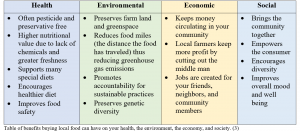You are What You Eat: Local Food Implications and Options
As we move deeper into the age of individually packaged snacks and drive through meals, it is important to step back and consider the impacts that our three meals a day create. I am empowered by the ability to incorporate sustainability into such a basic part of my daily life. Food not only fuels my physical and mental health, but creates a sense of family and community with the people around my table. We all have to eat to live, so why not make purchases that can positively impact not only your body; but the natural environment, local economy, and even your community?
The Food Well Alliance reports that 1 in 3 metro Atlanta adults are obese and 3 of 4 metro Atlanta adults do not consume the recommended 2.5 cups of fruits and vegetables daily. (1) As Mario Cambardella, the City of Atlanta’s first Urban Agriculture Director stated: “Whether as a response to issues of food security, nutrition, education, environmental degradation, public health and community well-being, locally grown foods are a multi-pronged solution to urban challenges that should not be overlooked.” (2) Buying local food can liven up your family’s kitchen and make dinner time fresh – literally!
Local food broadly describes anything consumable that was grown or raised in a close geographical area – from fruits and vegetables to meat and dairy. There are many benefits to locally grown food that can be broken up into different categories – physical health, environmental, economic, and social. The highlights of these categories have been expanded below:

As a college student, it can be hard to afford services like weekly farm shares or to find the time to go to a farmers market during my hectic week. That being said, the resources I find that support sustainable eating throughout Atlanta are incredible. I am still able to make small weekly choices that can make a compounding difference over time; such as buying snacks in bulk at Sevananda, a co-op market in Little Five Points, or eating veggies grown in the Georgia Tech Community Garden! I even get to splurge at the Piedmont Park Green Market once a month or so, getting specialty vegan cheeses or freshly baked bread directly from the makers. It might not sound like much, but I am comforted by the fact that if the people around me also make these little choices, together we can make huge environmental, social, and economic changes in favor of achieving a better model of food consumption.

Map of Farmers Markets inside Atlanta’s perimeter.
The United States Department of Agriculture has a comprehensive database of local markets around the country. (4) Check out this map with names and locations inside the perimeter! There are a wide variety of products sold at each of these 17 markets – from honey and eggs to soap and pet food.
Please visit the USDA database if you are looking for a farmers market outside of the perimeter or more details on what is offered at each location!
Resources:
-
https://leadership.saportareport.com/sustainable-communities/2019/05/20/what-does-food-insecurity-look-like-in-atlanta/
-
https://www.foodwellalliance.org/10-questions
-
https://arrowquip.com/blog/animal-science/top-benefits-buying-locally-grown-food
-
https://www.ams.usda.gov/local-food-directories/farmersmarkets





